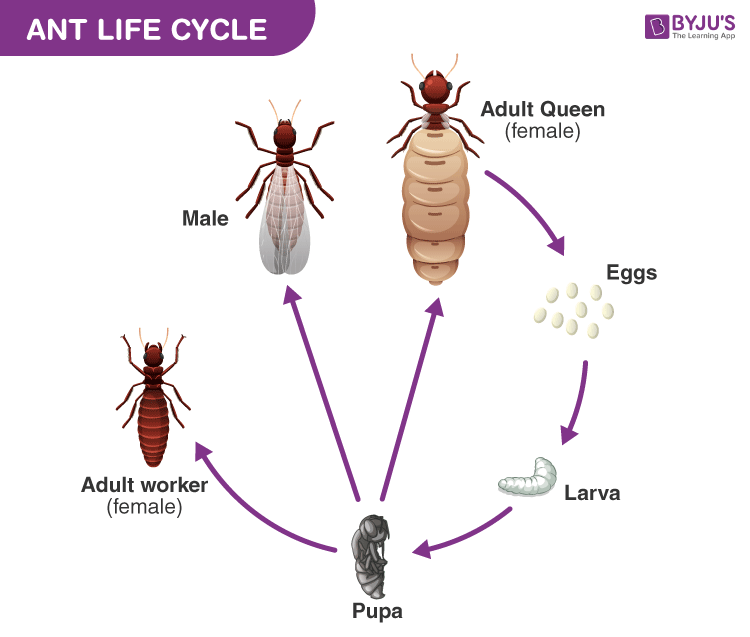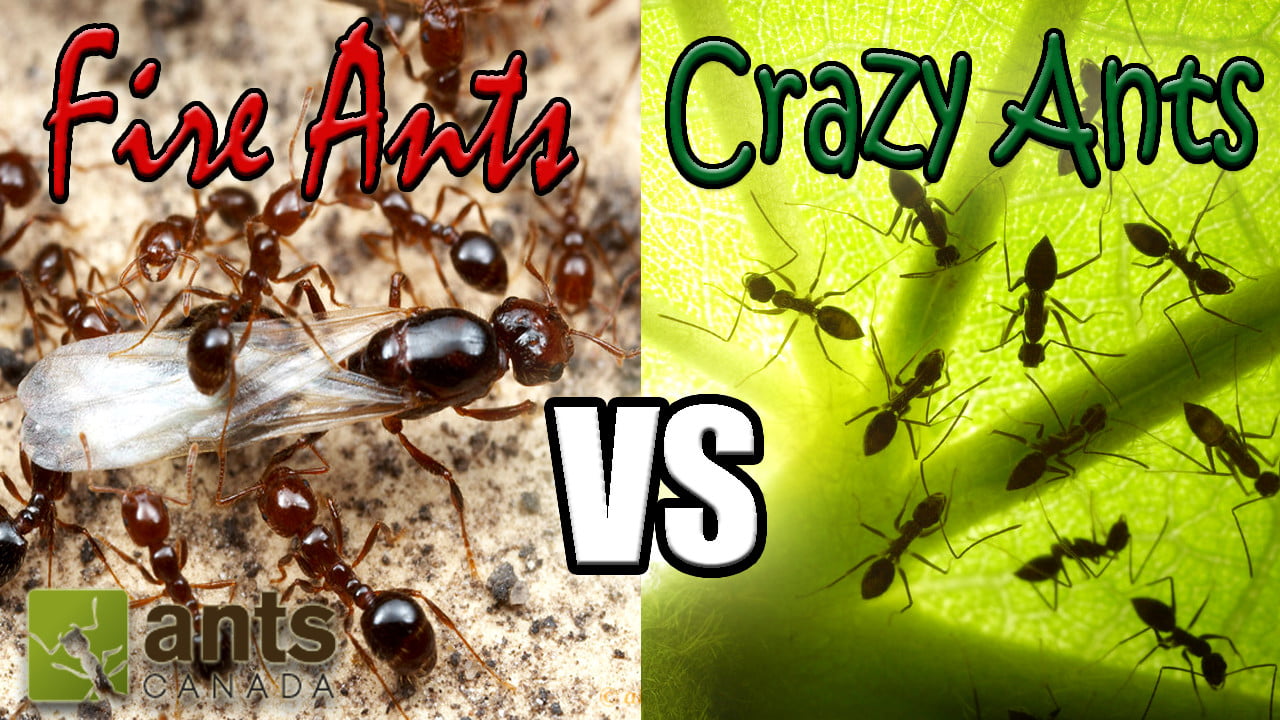Ants reproduce by laying eggs, which hatch into larvae and eventually develop into adult ants. Ant reproduction involves the laying of eggs by the queen, which then hatch into larvae.
The larvae grow and develop through several stages before emerging as adult ants. Understanding the process of ant reproduction can help in controlling and managing ant populations effectively. By being aware of the reproductive cycle, it becomes easier to implement strategies to prevent infestations and reduce the presence of ants in a given area.
Additionally, knowing how ants reproduce can aid in the development of targeted pest control methods that specifically disrupt their breeding and nesting behaviors.

Credit: animalcorner.org
Life Cycle Of Ants
Egg Stage
Ant reproduction starts with the egg stage, where queen ants lay eggs in underground nests.
Larva Stage
During the larva stage, ant eggs hatch into tiny larvae that require feeding by adult ants.
Pupa Stage
Next is the pupa stage, where the larvae spin a cocoon and undergo metamorphosis.
Adult Stage
In the final stage, the transformed pupae emerge as adult ants ready to work within the colony.

Credit: byjus.com
Reproduction In Ants
In the world of ants, reproduction is a fascinating and vital component of their life cycle. Understanding the process of reproduction in ants can offer insight into their social structure and behavior. From queen ants to male and worker ants, each plays a crucial role in the reproduction and continuation of ant colonies.
Queen Ant
The queen ant is the primary reproductive member of the colony, responsible for laying thousands of eggs. She occupies a central role in the ant society, and her ability to reproduce is essential for the survival and growth of the colony.
Male Ant
The male ant, also known as the drone, has a singular purpose – to mate with the queen. Males in ant colonies typically have a short lifespan as their sole duty is reproductive in nature.
Worker Ant
The worker ants, which are all females, are responsible for caring for the queen, tending to the brood, and maintaining the nest. They also forage for food and defend the colony against intruders. Despite their diverse responsibilities, worker ants do not mate and thus do not contribute directly to the reproductive process.
Mating Behavior
Mating Behavior:Ant reproduction relies heavily on the mating behavior of these industrious insects. Understanding the unique processes involved can offer insight into managing and controlling ant populations in and around your property.
Nuptial Flight
Nuptial flight, also known as swarming, marks the beginning of the mating process for ants. During this phenomenon, winged male and female ants take to the air in search of a suitable mate. This is a crucial stage in the lifecycle of ants, allowing for genetic diversity and the establishment of new colonies.
Mating Process
The mating process for ants occurs predominantly during the nuptial flight. Once the males and females have mated, the males die, and the fertilized females land to seek a suitable nesting site. They then shed their wings to begin the process of establishing a new colony. This process showcases the complexity and efficiency of ants in their reproductive endeavors.
Nesting Habits
Ants reproduce by laying eggs in structured nests, ensuring survival of their species. The colony system involves multiple phases, from mating to caring for the young. The complexity of their nesting habits ensures the growth and sustainability of ant populations.
The nesting habits of ants play a crucial role in their reproduction process. Understanding how ants create their nests provides insight into their behavior and life cycle.Queen’s Nest
The queen ant establishes the primary nest where she lays eggs and the colony begins.Ant Colony
Worker ants expand the colony by creating satellite nests for food storage and raising young.Ant colonies vary in size based on the species and environmental conditions.Each nest in the colony serves a specific purpose, from nurseries for larvae to food storage areas.Ants reproduce and thrive within their nests, staying organized and efficient in their tasks.The intricate nesting habits of ants showcase their remarkable social structure and adaptability.Ants scatter pheromones to communicate and navigate within their nests, maintaining order and cooperation.Ant colonies reflect a complex network of interconnected tunnels and chambers where ants work together to ensure survival.Ant Colony Growth
Welcome to another fascinating segment of our series on the reproduction of ants. In this section, we will delve into the remarkable process of ant colony growth. Ants are not solitary insects, but rather highly social creatures that thrive in colonies. Understanding how ant colonies grow and expand can give us insight into their intricate and organized society. Let’s explore three key aspects of ant colony growth: the expansion of the nest, the division of labor, and the continuous increase in population.
Expansion Of Nest
Ants are diligent nest builders, constantly expanding and modifying their nests to accommodate the growing population. As an ant colony thrives, the need for more living space becomes inevitable. This expansion is driven by the need to create ample room for brood chambers, food storage, and intricate tunnel systems. Ants achieve this by excavating soil or creating nests in tree trunks, cracks in pavement, or even within our homes.
Their nests are often engineered with precision, with separate chambers designated for specific tasks. The intricate network of tunnels optimizes ventilation, temperature control, and protection from predators. Each ant has its own role and contributes to the growth and maintenance of the nest. Building and expanding the nest is a collective effort that keeps the colony thriving.
Division Of Labor
As the ant colony grows, a highly specialized system of labor division emerges. This division allows ants to perform different roles and responsibilities efficiently, ensuring the smooth functioning of the colony. The division of labor is primarily based on the age and physical development of the ants.
The younger ants are responsible for tasks such as tending to the queen, caring for the brood, and cleaning the nest. As they mature, they take on roles such as foraging for food, defending the colony, or exploring new territories. This specialization streamlines efficiency and maximizes the colony’s productivity, enabling them to adapt and respond effectively to changing environmental conditions.
Increase In Population
The growth of an ant colony is driven by the continuous increase in population. Ants reproduce at an astonishing rate, with the queen laying eggs in large quantities. These eggs eventually hatch into larvae, which are cared for by the worker ants. The larvae undergo metamorphosis and transform into pupae, ultimately emerging as adult ants. This constant cycle of reproduction ensures a consistently growing population within the colony.
As the ant population increases, so does the influence and impact of the colony. More workers mean increased efficiency in acquiring resources, defending territory, and caring for the brood. The continuous increase in population allows ant colonies to thrive and expand their presence in their surroundings.
In summary, ant colony growth is a fascinating process involving the expansion of the nest, the division of labor, and the continuous increase in population. These interconnected aspects contribute to the resilience and success of ant colonies, allowing them to thrive in diverse environments and dominate their surroundings.
Environmental Factors
Ants reproduce in response to environmental cues such as temperature, humidity, and food availability. These factors play a crucial role in the ant’s reproductive behavior, influencing the timing and success of their mating flights and colony establishment. Understanding the environmental triggers for ant reproduction can help in managing and controlling ant populations effectively.
Introduction: Environmental Factors
The reproduction of ants is influenced by various environmental factors that play a crucial role in determining their population dynamics. Understanding these factors is essential for effective ant control. In this section, we will delve into three important aspects that impact ant reproduction: temperature, humidity, and food availability. Let’s explore how each of these factors contributes to ant reproduction success.Temperature
Temperature plays a significant role in the reproductive success of ants. Most ant species have a preferred temperature range at which their colonies thrive and reproduce efficiently. Temperatures too high or too low can hinder the reproduction process. For instance, if the temperature exceeds the upper limit, it can negatively impact egg development and the survival of larvae and pupae. On the other hand, excessively low temperatures can slow down ant activity and hinder the mating process. Thus, maintaining an optimal temperature level within ant-infested areas is crucial to encourage or inhibit their reproductive activities.Humidity
Humidity is another vital environmental factor affecting ant reproduction. Most ant species prefer moderate to high humidity levels for successful reproduction. High humidity promotes egg development and provides an ideal environment for larvae and pupae to thrive. In contrast, low humidity can hinder the reproductive cycle of ants, leading to decreased egg-laying and reduced survival rates. Maintaining suitable humidity levels can therefore significantly influence ant populations within a given area.Food Availability
Food availability directly impacts ant reproduction rates. Adequate access to food sources ensures a continuous supply of energy required for egg production and colony growth. Ants are known for their communal foraging behaviors, seeking nourishment in the vicinity of their nest. A diverse range of food sources, including carbohydrates, proteins, and fats, is essential to meet the nutritional needs of ant colonies. Insufficient food supply can result in reproductive failure, reduced egg production, and overall decline in the colony’s population.In conclusion, understanding the environmental factors that influence ant reproduction is crucial for effective ant management. Temperature, humidity, and food availability play significant roles in determining the reproductive success of ants. By considering and managing these factors, we can effectively control ant populations and minimize their impact.
Credit: www.mcgill.ca
Frequently Asked Questions Of How To Ant Reproduce
How Do Ants Reproduce?
Ants reproduce through a process called “metamorphosis. ” The queen ant lays eggs, which hatch into larvae. The larvae then go through several stages of growth before becoming adult ants. This process allows ants to multiply and form new colonies.
How Many Eggs Does A Queen Ant Lay?
A queen ant can lay thousands of eggs in her lifetime. The exact number of eggs depends on the species of ant and the conditions of their environment. The queen’s main purpose is to reproduce and ensure the survival of the colony.
How Long Does It Take For Ant Eggs To Hatch?
The time it takes for ant eggs to hatch varies depending on the species and environmental factors. Typically, ant eggs hatch within a few weeks. Once hatched, the larvae go through stages of growth before becoming adult ants.
What Is The Role Of Male Ants In Reproduction?
Male ants, also known as drones, have the sole purpose of mating with the queen. Once they have fulfilled their role in reproduction, male ants typically die shortly after. Their primary function is to ensure the genetic diversity of the colony.
Conclusion
Understanding how ant reproduce can help in managing infestations more effectively. By knowing their reproductive cycle, habitats, and behaviors, you can take the necessary steps to control their population. Implementing preventive measures and seeking professional help when needed ensures a pest-free environment in your home.

I’m MD Tanvir, and I bring years of expertise gained from working closely with pest control companies to the forefront. My journey in the industry has inspired me to launch Bug Battler, a platform aimed at equipping people with the know-how to combat pests autonomously. Through Bug Battler, I aim to empower individuals with practical insights to tackle pest infestations effectively.

